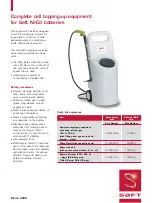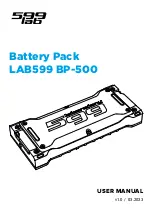
SENS MicroGenius S2/S4 Technical Manual
41
Figure 16 – Example Temperature Compensation Curves
9.13.
Load Share Charger Operation
Multiple chargers may be connected in parallel to provide charger redundancy and increased charging
current. Load sharing chargers are fault tolerant; one charger failure will not cause failures in paralleled
chargers.
9.13.1.
Load Sharing and Synchronization
Connection of a network cable between chargers using the SENSbus RJ-45 connectors (see
section
6.9
) automatically initiates load sharing synchronization of operating modes. Chargers will
share the current load 10%. For proper load share operation, a 120-ohm terminator is
required at the ends of the bus. Chargers intended for load sharing must be configured with the
same output settings in order to load share properly. A charger in a multi-charger load sharing
system with different output settings will not load share properly. Corresponding outputs must be
configured with the same output settings for chargers with multiple outputs. Load sharing
operates independently on each output for chargers with multiple outputs. Connect
corresponding outputs of load sharing chargers in parallel (i.e. connect output A to output A).
Load sharing will not occur if non-corresponding outputs are connected (e.g. do not connect
output A to output B).The LOAD SHARE FAIL alarm will occur any time a charger is unable to load
share. If a charger in a multi-charger load sharing system fails or is disconnected the remaining
chargers will still load share and ignore the faulted charger. Each load sharing charger will alarm
independently using individually configured alarm setpoints.
The output voltage and current of each individual charger will be shown on the front panel LCD. If
an optional remote alarm/communications panel accessory (not included internal to charger) is
connected it will display only the system output voltage and current. An alarm/communications
circuit board that is configured for an individual charger can be set to show system information by
using the SENS Setup Utility.
Chargers connected in parallel without the load sharing network cable will operate but without
synchronization. Current is not shared between chargers, Boost and HELIX modes are not
synchronized and the system voltage is not displayed on the LCD. The chargers must be set for the
same voltage range (12V or 24V) and Float voltage. When load sharing is disabled, boost mode
should also be disabled on all but one charger to avoid conflicts between chargers. As a result,
redundancy of Boost output voltage is not included when load sharing is not employed.
















































